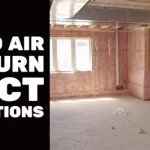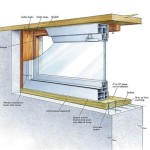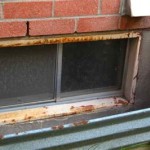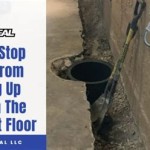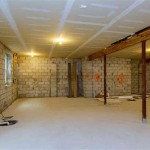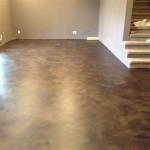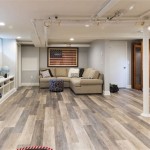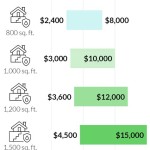Cost to Drywall a 1200 Sq Ft Basement: A Comprehensive Guide
Drywalling a basement is a common undertaking, offering the opportunity to transform an unfinished space into a functional and comfortable living area. Understanding the costs associated with this project is crucial for budgeting and planning purposes. The cost to drywall a 1200 sq ft basement can vary significantly based on several factors, including material costs, labor rates, the complexity of the basement layout, and any additional work required, such as framing or insulation.
This article provides a comprehensive overview of the various cost components involved in drywalling a 1200 sq ft basement, offering a detailed analysis to help homeowners estimate their potential expenses accurately. We will explore the individual costs of materials like drywall sheets, joint compound, and fasteners, as well as the labor expenses involved in hanging, taping, and finishing the drywall. Furthermore, we will examine the impact of additional factors, such as the need for framing, insulation, or moisture-proofing, on the overall budget.
A 1200 sq ft basement doesn't automatically translate to 1200 sq ft of drywall needed. One must account for the height of the walls, and the ceiling area as well. Therefore, calculating the surface area requiring drywall is paramount. For example, assuming an 8-foot ceiling, the wall surface area would be approximately 320 linear feet (1200 / 3.75, assuming the basement is roughly rectangular and equally divided between length and width) multiplied by 8 feet, equaling 2560 sq ft. Adding the 1200 sq ft ceiling area, the total drywall area is around 3760 sq ft. This figure is crucial for accurately estimating material needs and labor costs.
Material Costs for Drywalling a Basement
The selection and quantity of materials directly impact the overall cost of the drywalling project. Drywall sheets are typically sold in 4x8 foot or 4x12 foot sizes. The choice depends on preference, ease of handling, and minimizing waste. Thicker drywall (5/8 inch) is often preferred for ceilings due to its greater sag resistance, while thinner drywall (1/2 inch or 3/8 inch) can be used for walls. Moisture-resistant (green board) or mold-resistant drywall is strongly recommended for basements due to the increased risk of humidity.
Drywall costs fluctuate based on thickness, type, and supplier. Standard 1/2-inch drywall panels typically range from $12 to $18 per sheet. Moisture-resistant drywall can cost between $18 and $25 per sheet. Considering the example surface area of 3760 sq ft, approximately 118 (4x8) sheets would be required. Therefore, the cost for standard drywall would range from $1416 to $2124. If moisture-resistant drywall is selected, the cost could be $2124 to $2950.
In addition to drywall panels, several other materials are necessary. Joint compound (mud) is used to conceal seams and screw holes, creating a smooth, paint-ready surface. Joint compound can be purchased in pre-mixed buckets or as a powder that requires mixing with water. A 5-gallon bucket of pre-mixed joint compound typically costs between $15 and $30. Several buckets may be required depending on the number of coats applied and the skill of the installer.
Drywall tape, either paper or mesh, reinforces the joints between drywall sheets. Paper tape is generally stronger, while mesh tape is easier to use for beginners. A roll of drywall tape typically costs between $5 and $10. Fasteners, such as drywall screws, are used to secure the drywall sheets to the framing. Drywall screws are relatively inexpensive, with a box of screws costing between $10 and $20. Other necessary materials include sandpaper, utility knives, corner bead (for finishing corners), and primer.
Labor Costs for Drywall Installation
Labor costs represent a significant portion of the overall drywalling project expense. Labor rates vary widely depending on the region, the experience of the contractor, and the complexity of the job. General contractors usually charge higher rates, but often provide project management and sub-contract out the drywalling to a specialist. Hiring a dedicated drywall contractor is often more cost-effective. Some contractors charge by the hour, while others charge by the square foot.
For drywall installation, labor can be broken down into several stages: hanging, taping, mudding, and sanding. Hanging drywall involves attaching the drywall sheets to the framing. This process requires precision to ensure that the sheets are properly aligned and securely fastened. Taping involves applying drywall tape over the seams between the sheets. Mudding involves applying joint compound over the tape and screw holes, creating a smooth surface. Sanding, finally, smooths out any imperfections after the mud has dried.
The average cost of labor for drywall installation ranges from $1.50 to $4 per square foot. Considering the example surface area of 3760 sq ft, the labor cost would range from $5640 to $15040. This range is broad, emphasizing the importance of obtaining multiple quotes from different contractors. Factors influencing labor costs include the height of the walls, the number of windows and doors, and the presence of any obstacles, such as pipes or ductwork.
It's important to note that some contractors may charge extra for removing old drywall, preparing the walls for new drywall installation, or painting the walls after the drywall has been finished. These additional services should be clearly outlined in the contract to avoid any unexpected expenses. Ensure a written contract is established before work starts to avoid miscommunication.
Additional Cost Considerations
Several additional factors can impact the total cost of drywalling a basement. These factors should be considered during the budgeting process to ensure that the project stays within the homeowner's financial means.
Framing is the structural support for the drywall. If the basement walls are not already framed, this will add to the cost. Framing involves building a wooden or metal framework to which the drywall sheets can be attached. The cost of framing depends on the type of material used (wood or metal), the complexity of the layout, and the labor rates of the framing contractor. Additionally, any required permits should be obtained before beginning the framing phase. The cost of materials and labor for framing can add several thousand dollars to the project.
Insulation is another crucial consideration, especially in basements, which tend to be colder and more humid than other areas of the house. Insulating the basement walls and ceiling can improve energy efficiency and reduce heating and cooling costs. The cost of insulation depends on the type of insulation used (e.g., fiberglass, spray foam, rigid foam) and the amount of insulation needed. Spray foam insulation is highly effective but also more expensive than fiberglass. Insulation costs, including material and labor, can range from $1 to $3 per square foot.
Moisture-proofing is essential in basements to prevent water damage and mold growth. Basements are particularly susceptible to moisture intrusion, which can damage the drywall and create unhealthy living conditions. Moisture-proofing measures can include applying a waterproof coating to the foundation walls, installing a sump pump, and ensuring proper drainage around the foundation. The cost of moisture-proofing depends on the severity of the moisture problem and the methods used to address it.
Electrical work is frequently required when finishing a basement. This includes installing outlets, switches, and lighting fixtures. Electrical work should be performed by a licensed electrician to ensure safety and compliance with local building codes. The cost of electrical work depends on the number of outlets and fixtures installed, the complexity of the wiring, and the electrician's labor rates. Budgeting for electrical work is a critical aspect of the basement finishing project and should not be overlooked.
Permits are often required for drywalling a basement, especially if the project involves structural changes or electrical work. Permit costs vary depending on the municipality and the scope of the project. Failing to obtain the necessary permits can result in fines and delays.
Painting is the final step in the drywalling process. Painting the walls and ceiling provides a finished look and protects the drywall from moisture and damage. The cost of painting depends on the type of paint used, the number of coats applied, and the labor rates of the painter. Homeowners can save money by painting the walls themselves, but hiring a professional painter can ensure a high-quality finish.
Therefore, the overall cost to drywall a 1200 sq ft basement can be a significant investment. By carefully considering all the factors discussed above, homeowners can develop a realistic budget and make informed decisions about their project. Obtaining multiple quotes from different contractors, carefully comparing prices, and paying attention to the details of the contract can help ensure that the project is completed on time and within budget.

Drywall A Basement Cost Real Estimate Services

Drywall A Basement Cost Real Estimate Services

Average Cost Of Drywall Installation Or Hanging Regional Foundation Repair

Compare Drywall Installation Cost Prices

Basement Remodel Costs

How Much Does It Cost To Drywall A Basement 2025

Drywall Cost Per Square Foot In Csg Renovation

Drywall Cost Estimator In Boca Raton Estimate Florida Consulting

2025 Drywall Installation Cost Hang Per Sqft

Basement Finishing Price Calculator Moose Basements
Related Posts
